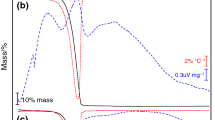Abstract
The Co(II)–diclofenac complex was evaluated by simultaneous thermogravimetry-differential thermal analysis (TG-DTA) and differential scanning calorimetry (DSC). The DTA curve profile shows one exothermic peak because of the transition phase of the compound between 170 and 180 °C, which was confirmed by X-ray powder diffractometry. The transition phase behavior was studied by DSC curves at several heating rates of a sample mass between 1 and 10 mg in nitrogen atmosphere and in a crucible with and without a lid. Thus, the kinetic parameters were evaluated using an isoconversional non-linear fitting proposed by Capela and Ribeiro. The results show that the activation energy and pre-exponential factor for the transition phase is dependant on the different experimental conditions. Nevertheless, these results indicate that the kinetic compensation effect shows a relationship between them.








Similar content being viewed by others
References
Demertzi DK, Theodorou A, Demertezi MA, Raptopoulou CP, Terzis A. Synthesis and characterization of Tetrakis-tx-2-[(2,6dichlorophenyl) amino] benzeneacetodiaquodicopper(II) dihydrate and Tetrakis-2-[(2,6dichlorophenyl) amino]benzeneaceto dimethylformamidodicopper(II). J Inorg Biochem. 1997;65:151–7.
Demertzi DK, Hadjikakou SK, Demertzi MA, Deligiannakis Y. Metal ion ± drug interactions. Preparation and properties of manganese (II), cobalt (II) and nickel (II) complexes of diclofenac with potentially interesting anti-inflammatory activity: behavior in the oxidation of 3,5-di-tert-butyl-o-catechol. J Inorg Biochem. 1998;69:223–9.
Kenawi IM. Density functional theory assessment of the thermal degradation of diclofenac and its calcium and iron complexes. J Mol Struct. 2005;754:61–70.
Bucci R, Magri AD, Magri AL, Napoli A. Spectroscopic characteristics and thermal properties of divalent metal complexes of diclofenac. Polyhedron. 2000;19:2515–20.
Kobelnik M, Bernabé GA, Ribeiro CA, Capela JMV, Fertonani FL. Kinetic of decomposition of iron (III)–diclofenac compound. J Therm Anal Calorim. 2009;97:493–6.
Kobelnik M, Cassimiro DL, Ribeiro CA, Dias DS, Crespi MS. Preparation of the Ca–diclofenac complex in solid state: study of the thermal behavior of the dehydration, transition phase and decomposition. J Therm Anal Calorim. doi: 10.1007/s10973-010-0787-8.
Kobelnik M, Quarcioni VA, Ribeiro CA, Capela JMV, Dias DS, Crespi MS. Thermal study in solid state of Zn(II)–diclofenac complex: behavior kinetic of the dehydration, transition phase and thermal decomposition. J Chin Chem Soc. 2010;57:384–90.
Malek J, Smreka V. The kinetic analysis of the crystallization processes in glasses. Thermochim Acta. 1991;186:153–69.
Koga N, Sestak J. Kinetic modeling of advanced inorganic glass-ceramics formation by crystal growth from pre-existing nuclei. J Therm Anal Calorim. 2000;60:667–74.
Malek J. Kinetic analysis of crystallization processes in amorphous materials. Thermochim Acta. 2000;355:239–53.
Capela JMV, Capela MV, Ribeiro CA. Rational approximations of the Arrhenius integral using Jacobi fractions and gaussian quadrature. J Math Chem. 2009;45:769–75.
Souza JL, Kobelnik M, Ribeiro CA, Capela JMV. Kinetics study of crystallization of PHB in presence of hydrociacids. J Therm Anal Calorim. 2009;97:525–8.
Koga N, Sesták J. Further aspects of the kinetic compensation effect. J Therm Anal Calorim. 1991;37:1103–8.
Koga N, Tanaka H. A kinetic compensation effect established for the thermal decomposition of a solid. J Therm Anal Calorim. 1991;37:347.
Zsakó J. Compensation effect in heterogeneous non-isothermal kinetics. J Therm Anal Calorim. 1996;47:1679.
Crespi MS, Hikosada MY, Amaral GCA, Ribeiro CA. Non-isothermal kinetic applied to thermal decomposition of commercial alkyd varnish. J Therm Anal Calorim. 2007;88:669.
Acknowledgements
The authors thank Brazilian agencies CAPES and CNPq for financial support.
Author information
Authors and Affiliations
Corresponding author
Rights and permissions
About this article
Cite this article
Kobelnik, M., Ribeiro, C.A., dos Santos Dias, D. et al. Study of the thermal behavior of the transition phase of Co(II)–diclofenac compound by non-isothermal method. J Therm Anal Calorim 105, 467–471 (2011). https://doi.org/10.1007/s10973-010-1208-8
Published:
Issue Date:
DOI: https://doi.org/10.1007/s10973-010-1208-8




